NCI Quick-Change Scientist Hesse Switches Roles, Pathogens

Earlier this year, infectious disease fellow Dr. Shayla Hesse was conducting research full-time in the developmental genetics section of NCI’s Laboratory of Molecular Biology in Bldg. 37. She and her colleagues were studying ways to fight bacteria that were stubbornly hardy against antibiotics. Then a novel coronavirus struck, Covid-19 emerged and Hesse immediately shifted gears.
“It’s surreal to think about how much has changed in a short span of time,” she says. “In February, I was focused on a very different type of virus—bacteriophage—with the goal of addressing a very different infectious disease threat—antibiotic-resistant bacteria. Incubators and centrifuges dominated my workspace. A mask was not part of my work apparel. Fast-forward to now and I, like many staff members, find myself working in a new capacity and in a rapidly evolving environment.”
Hesse recalls relying on her clinical training to repurpose herself as a volunteer at a Covid-19 drive-through test site that NIH’ers stood up quickly on campus. Within a few short weeks, she had drafted the site’s standard operating procedures. Head and neck anatomy turned out to be a key procedural consideration.
“There I observed hundreds of nasopharyngeal swab samplings,” she explains, “and developed a sense of some of the finer aspects of the technique. I never thought I’d find myself carrying on a 20-minute conversation about the best strategy for navigating a flimsy instrument around the nasal turbinates! I have since transitioned to a different role as part of a Covid-19-specific team of medical providers. Although I’ve amassed only a modest amount of experience on that service so far, I’ve found the highly variable and, in some cases, rapidly progressive nature of the disease to be both humbling as well as harrowing.”
Several of her new coworkers call Hesse’s contributions invaluable. And despite the unusual workload, new work environment and unsettling uncertainty the global pandemic has brought, Hesse says she feels a deep sense of pride being in the thick of the agency’s crisis response.
“It is a time in which challenges abound, at NIH and everywhere,” Hesse acknowledges. “Over the past few weeks, I’ve seen the collaborative spirit that is the hallmark of the Intramural Research Program carry over to new endeavors and non-research-based contexts. I’ve seen employees across institutes rise to meet incredible demands. I’ve read research reports by intramural investigators that materially enhance our understanding of this novel pathogen, and I’ve watched as our institutional leaders help guide the national pandemic response. I’ve always felt honored to be part of the NIH community—and now more than ever.”—Carla Garnett
